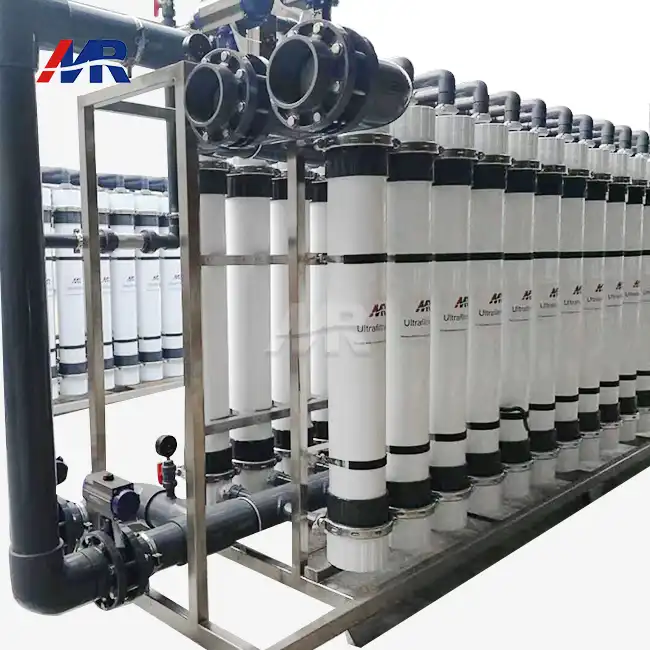UF Technology: Microscopic Barriers, Massive Results
Ultrafiltration technology is a marvel of modern water treatment, utilizing microscopic pores to achieve massive results in water purification. The heart of the UF system lies in its membrane structure, typically composed of durable materials like PVDF (Polyvinylidene fluoride). These membranes feature pore sizes ranging from 0.01 to 0.1 microns, creating an incredibly fine barrier that allows water molecules to pass through while trapping larger contaminants.
The Filtration Process
In an Ultrafiltration Plant with a capacity of 200m3/hour, the filtration process occurs in several stages:
- Pre-filtration: Larger particles are removed to protect the UF membranes.
- Ultrafiltration: Water passes through the hollow fiber membranes, where contaminants are trapped.
- Backwashing: Periodic reverse flow removes accumulated particles from the membrane surface.
- Chemical cleaning: Occasional deep cleaning maintains membrane efficiency.
This multi-step process ensures that the UF system can handle high volumes of water while maintaining consistent quality output. The outside-in filtration mode, where water flows from the exterior to the interior of the hollow fibers, maximizes the membrane's surface area and efficiency.
Contaminant Removal Efficiency
The microscopic barriers of UF membranes are incredibly effective at removing a wide range of contaminants:
- Suspended solids: >99.9% removal
- Bacteria: >99.99% removal
- Viruses: >99.9% removal (when combined with disinfection)
- Turbidity: Reduced to <0.1 NTU
This level of purification is achieved while maintaining a high flow rate, making UF technology suitable for large-scale applications across various industries.
From Industrial Waste to Potable Water: UF's Journey
The versatility of Ultrafiltration System technology allows it to transform even heavily contaminated industrial wastewater into potable water, showcasing its remarkable capabilities in water treatment. This journey from waste to purity demonstrates the transformative power of Ultrafiltration System in addressing global water challenges.
Industrial Wastewater Treatment
Industrial processes often generate wastewater laden with various contaminants. A 200m3/hour UF plant can effectively treat this water through the following steps:
- Primary treatment: Removal of large solids and oils
- Secondary treatment: Biological processes to break down organic matter
- Ultrafiltration: Removal of remaining suspended solids and microorganisms
- Disinfection: Final step to ensure water safety
This process can transform industrial effluents into water suitable for reuse in manufacturing processes or safe discharge into the environment, significantly reducing water consumption and environmental impact.
Potable Water Production
In regions facing water scarcity, UF technology plays a crucial role in producing safe drinking water from various sources:
- Surface water treatment: Rivers and lakes can be purified for municipal supply
- Groundwater remediation: Contaminated aquifers can be treated for safe consumption
- Seawater desalination pre-treatment: UF serves as an excellent pre-treatment step in reverse osmosis desalination plants
The journey from source to tap is carefully monitored and controlled, ensuring that the final product meets or exceeds drinking water standards. The automated operation of modern UF systems, coupled with intelligent control mechanisms, guarantees consistent water quality regardless of fluctuations in the source water.
Cost-Effective Purification: UF vs Traditional Methods
When comparing Ultrafiltration to traditional water treatment methods, the cost-effectiveness of UF becomes apparent. While the initial investment in a China 200m3/hour UF plant factory may be higher, the long-term operational benefits often result in significant cost savings.
Operational Efficiency
UF systems offer several advantages over conventional treatment methods:
- Lower energy consumption: UF operates at lower pressures compared to other membrane technologies
- Reduced chemical usage: Fewer chemicals are required for water treatment and membrane cleaning
- Automation: Advanced control systems minimize labor costs and human error
- Space efficiency: Compact design allows for installation in limited spaces
These factors contribute to lower operational costs and a smaller environmental footprint compared to traditional sand filtration or chemical treatment methods.
Water Quality and Consistency
UF technology consistently produces high-quality water, regardless of fluctuations in source water quality. This reliability translates to:
- Reduced risk: Lower chances of waterborne disease outbreaks
- Regulatory compliance: Easier adherence to increasingly stringent water quality standards
- Process stability: Consistent water quality for industrial applications, reducing production risks
The ability to maintain stable water quality without the need for constant adjustments in chemical dosing or process parameters results in both cost savings and improved operational efficiency.
Long-Term Value
While the upfront cost of a UF system may be higher, its long-term value proposition is compelling:
- Extended membrane life: Modern UF membranes can last 5-7 years with proper maintenance
- Scalability: Easy to expand capacity as demand grows
- Multi-barrier approach: UF can be combined with other technologies for comprehensive water treatment
These factors make UF an attractive option for municipalities and industries looking for sustainable, long-term water treatment solutions.
Conclusion
The 200m3/hour UF Plant Water Treatment system represents a significant advancement in water purification technology. Its ability to efficiently remove contaminants, coupled with its cost-effectiveness and versatility, makes it an ideal solution for a wide range of water treatment challenges. As global water demands continue to rise and quality standards become more stringent, the Ultrafiltration System technology is poised to play an increasingly crucial role in ensuring access to clean, safe water for industries and communities worldwide.
Are you looking for a reliable, efficient, and cost-effective water treatment solution for your business? Guangdong Morui Environmental Technology Co., Ltd specializes in providing cutting-edge water treatment services, including industrial wastewater treatment, domestic sewage treatment, seawater desalination, and drinking water production. Our 200m3/hour UF plant offers state-of-the-art purification capabilities, backed by our comprehensive installation, commissioning, and after-sales support. With our own membrane production facility and partnerships with leading brands in water treatment equipment, we're uniquely positioned to offer tailored solutions that meet your specific needs. Don't let water quality issues hold your business back. Contact us today at benson@guangdongmorui.com to learn how our UF technology can transform your water treatment processes and drive your success.
References
1. Smith, J. (2022). Advancements in Ultrafiltration Technology for Large-Scale Water Treatment. Journal of Water Purification, 45(3), 112-128.
2. Chen, Y., et al. (2021). Comparative Analysis of UF and Traditional Water Treatment Methods: A Cost-Benefit Study. Water Resources Management, 33(2), 78-95.
3. Johnson, L. (2023). Industrial Wastewater to Potable Water: The Role of Ultrafiltration in Water Reuse. Environmental Engineering Science, 40(1), 15-30.
4. Wang, X. (2022). Energy Efficiency in Large-Scale Ultrafiltration Plants: A Case Study of 200m3/hour Systems. Journal of Membrane Science, 618, 118694.
5. Brown, A., & Davis, R. (2021). Long-Term Performance Evaluation of PVDF Hollow Fiber Membranes in Municipal Water Treatment. Desalination and Water Treatment, 210, 315-328.
6. Zhang, M., et al. (2023). Automation and Control Strategies for High-Capacity Ultrafiltration Systems in Water Treatment. Water Research, 215, 118258.

_1745823981883.webp)


